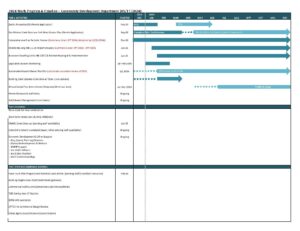At Thursday’s Economic Development Committee meeting, staff informed the council committee that plans to restore sound reduction requirements to the building code, which had been removed in 2012, had been put on hold indefinitely. In discussing the Planning Department’s calendar for 2024, staff said there were a large number of higher priority tasks, and that the issue would likely require an outside consultant to study the issue.
Background
In 1986, cities around Sea-Tac Airport began incorporating sound reduction into their building codes in order to mitigate the increasing noise from Sea-Tac Airport. The most recent version of that for Des Moines was Ordinance #1407.
However, in 2012, the City of Des Moines rescinded those portions of their sound code via Ordinance #1539. Notably, Burien and SeaTac did not follow suit.
WHEREAS, the development community frequently cites the City’s Sound Code as unnecessary, not economically justified and overly burdensome to both home owners who want to upgrade their windows or remodel their homes, or developers looking to provide the lowest cost product to their customers…
In 2023, Councilmember JC Harris moved to have the City reverse that ordinance, in effect simply restoring the original language providing for noise reduction in city building code, language which both Burien and SeaTac still have. The Council voted to send the issue to the EDC for review.
Too much work?
 But today’s staff briefing, which divided the Planning Department’s tasks into three priority tiers, relegated sound code to Tier 2–items that are unfunded and unscheduled.
But today’s staff briefing, which divided the Planning Department’s tasks into three priority tiers, relegated sound code to Tier 2–items that are unfunded and unscheduled.
Mayor Traci Buxton raised the issue:
“One thing we had talked about this fall to bring back, and it appears on tier two was to reinstate the old noise code, that I think that… Back in the day, maybe there was some misunderstanding about whether it was in compliance with, like the Standard Building Code or something? Anyway do you is that one of the things that’ll be under consideration?”
(Just to be clear, rescinding the sound code in 2012 had nothing to do with compliance to any regulatory standards.)
The confusion continued. Staff appeared to be echoing language in Ordinance #1539 that was bogus in 2012 and is still used by the Port of Seattle to oppose Port Package Update legislation now making its way through Olympia. Referencing the Part 150 program, which defines the area considered noise-impacted enough to merit sound insulation, one staff member suggested that ‘planes are quieter now’ as a possible reason to question the need for sound reduction building code.
But basically in a nutshell there was that Part 150 study that’s ongoing with Boeing, or sorry, Port of Seattle, and there was some information from that study that seemed to have shrunk the map and lessen the noise. The claim was my understanding of it. So I can give you what I have and why we repealed it in the first place, and then you could as a group decide whether or not you want to figure out what it would take to reinstate it.
Another argument made by staff also seemed to echo Ordinance #1539:
WHEREAS, continuing improvements in State building and energy codes are resulting in quieter homes…
This argument is illogical. If builders are already exceeding the required standards, what possible harm would it do to restore those standards?
Analysis
Harris’ 2023 motion was specific and simple: restore the previous sound code. The point was simplicity for all parties: developers, the City, and residents who will be occupying upcoming building projects.
- Regardless of what the FAA says, any person living under the flight path knows that the average noise level is much greater than in 2012 and covers a much broader area.
- Builders have continued to build profitably in Burien and SeaTac–despite having sound code requirements.
- The City could restore the previous standards (again matching our sister cities) and then move forward to upgrade the current building code to afford greater sound reduction requirements (as recommended by all current health studies) when staff have greater bandwidth.
This points out an ongoing problem with making progress on airport issues: continuity of knowledge. It’s not only residents who now move in and out of the area frequently, it’s municipal employees. Even the best trained engineers and planners are unlikely to have had prior experience working in an airport community. Therefore, it is up to city councils in cities like Des Moines, SeaTac and Burien to insist that their staff make sound code a shared value that gets transmitted from one generation to the next.
Beyond that, if we don’t expect more from local government on issues we do have control over, how can we expect the Port, State or Federal governments to do more on issues we don’t control?